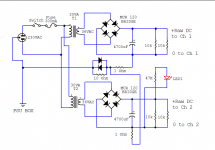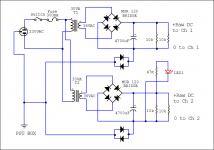Maybe a a compact size raw DC rail filter added in the phono box sitting between the umbilical and the channels DC input connectors can bring benefit beyond some passive parts details.
Of course a very balanced design between isolation performance and low output impedance is Keantoken's. Recommended for a before & after test to the handier Folded Simplistic near future builders.
Will report soon 🙂
the 18v TX are home... now waiting for some new perfboards.
Whatever it can be produced in the rectification or it can intrude the long power cabling.
In my prototype I could not make it catch a GSM phone buzz and I never trimmed its TPs again not noticing intermittent noises, neither a tonal nor an image shift, since I closed its lid in August. That is stock with basic PSU as it is described in the guide.
This does not mean that other builders will not aspire to more elaborate main PSUs or will not want to try some add on filter, whatever.
Freedom of personalized packaging and configuration, favorite passive parts etc. is part of the joy of building DIY audio.
Sure ! an RC network seems most logic .. LC perhaps more effective . though inductive components can easily cause problems inside the signal box 😕
THX , Paul
No reason for expensive bulky passive filter components in the phono box IMHO. If that small Sziklai capacitance multiplier that Keantoken has tuned nicely can not cut the mustard so to perceptibly enhance PSU incoming line isolation quality then no passive can. It should reside an inch or so between the channels input DC connectors made in double mono of course.
interesting reading about that cap. multiplier thingy .. curious how it works out of course .
but for now .. trying to locate suppliers for the exotic bjt etc. a real challenge on it's own 🙄
THX again Salas !!
Paul
but for now .. trying to locate suppliers for the exotic bjt etc. a real challenge on it's own 🙄
THX again Salas !!
Paul
just found 2 pcs of SK146 dual jfets in my stash 🙄
an interesting find if you ask me ....
THX
Paul
an interesting find if you ask me ....
THX
Paul
THX !
yes , there's clearly a red dot on the tincan . but than ...
the fets are facing each other inside the can , how can the red dot
identify the drains while mirror faced 😕
funny
yes , there's clearly a red dot on the tincan . but than ...
the fets are facing each other inside the can , how can the red dot
identify the drains while mirror faced 😕
funny
There are two JFETs inside with their flat faces touching, its original sheet gives such pin out so its valid. That is an old TOSHIBA matched and thermally bonded pair. K369 level spec. Unobtanium or $70-100 if someone with a small stash would want to give just one pair. So you are lucky. If it is BL even luckier.
P.S. Don't forget that in most JFETs D&S can be equivalent and only the gate location matters.
THX Salas ,
Lucky me 😀 realy thought I ran out of luck over the years but the gods seem to still be on my side .. T.G. !!
gods seem to still be on my side .. T.G. !!
Would you use these paralleled , or stereo wise ( one dual fet for L+R channel ) ?
THX , Paul
ps: got two GR versions and just find two more BL ones 😱
Lucky me 😀 realy thought I ran out of luck over the years but the
 gods seem to still be on my side .. T.G. !!
gods seem to still be on my side .. T.G. !!Would you use these paralleled , or stereo wise ( one dual fet for L+R channel ) ?
THX , Paul
ps: got two GR versions and just find two more BL ones 😱
I would use them as paralleled front ends in the simplistic MC channels or in low noise diff amp JFET input stages in other circuits. But I would confirm their matching level first.
Is a line amp needed for buffering?
Hope this is not the fifth time this has been asked but if one does not need the extra gain would there be any reason to use a line stage?
Thanks for letting me stop wondering if I need to use an LCR RIAA filter.
Take care,
Hope this is not the fifth time this has been asked but if one does not need the extra gain would there be any reason to use a line stage?
Thanks for letting me stop wondering if I need to use an LCR RIAA filter.
Take care,
Rick, to give you a practical overview:
I use 63dB voltage gain for a Denon DL-103R 0.25mV LMC cart in my FS PCB prototype. My control preamp is configured for X1 gain (0dB). My CFA power amp for X20 gain (26dB).
My speakers are 94-95dBSPL/W sensitive. They are 8 Ohm but they dip to a 4 Ohm minimum mid-bass plateau. I drive them with the system voltage gain structure I described in 40W MOSFET class A power reserve.
The control preamp's log volume pot gives me practically same SPL either for the Benchmark DAC or the Folded Simplistic at same positions. Some records play louder than the CDs even.
At 12 o'clock I enjoy "loud" peaks at four meters from the speakers that can cover a vivid conversation. Beyond 2 o'clock its just "too loud".
The Folded simplistic has a JFET buffer output stage itself of about 50 Ohm impedance and similar design to a capacitor coupled B1.
I hope that I have given you enough example info to weigh and decide your own configurations.
I use 63dB voltage gain for a Denon DL-103R 0.25mV LMC cart in my FS PCB prototype. My control preamp is configured for X1 gain (0dB). My CFA power amp for X20 gain (26dB).
My speakers are 94-95dBSPL/W sensitive. They are 8 Ohm but they dip to a 4 Ohm minimum mid-bass plateau. I drive them with the system voltage gain structure I described in 40W MOSFET class A power reserve.
The control preamp's log volume pot gives me practically same SPL either for the Benchmark DAC or the Folded Simplistic at same positions. Some records play louder than the CDs even.
At 12 o'clock I enjoy "loud" peaks at four meters from the speakers that can cover a vivid conversation. Beyond 2 o'clock its just "too loud".
The Folded simplistic has a JFET buffer output stage itself of about 50 Ohm impedance and similar design to a capacitor coupled B1.
I hope that I have given you enough example info to weigh and decide your own configurations.
Hi,
What are the recommended power transformer ratings (secondary voltage and current) for the Folded kit? (An E-I transformer will be ordered from a local transformers workshop).
What are the recommended power transformer ratings (secondary voltage and current) for the Folded kit? (An E-I transformer will be ordered from a local transformers workshop).
It isn't for me, it's for a person I recommended to the kit. It may well be point to point I'll do the soldering of the Folded PCB and the PSU. Is there a PCB for the PSU?
I meant asking about the phono itself if p2p so to know the intention of using external regs of higher CCS or not VS the VA rating of the transformers.
The PSU does not need a PCB. Its very basic. Its ground loop breaking scheme worked for no loops in my system. As in the guide and in the first picture here.
In case it does not in some other systems, then an alternative I can suggest is in the second picture. More I can not predict since the system grounding is a general matter that varies between installations and has not to do with the main phono build.
The PSU does not need a PCB. Its very basic. Its ground loop breaking scheme worked for no loops in my system. As in the guide and in the first picture here.
In case it does not in some other systems, then an alternative I can suggest is in the second picture. More I can not predict since the system grounding is a general matter that varies between installations and has not to do with the main phono build.
Attachments
Thanks, Salas.
The Folded will be installed on the group buy PCB, with the included shunt regulators.
As for possible ground loops, they will be dealt with later, if and when they may come.
The Folded will be installed on the group buy PCB, with the included shunt regulators.
As for possible ground loops, they will be dealt with later, if and when they may come.
- Home
- Source & Line
- Analogue Source
- Simplistic NJFET RIAA

